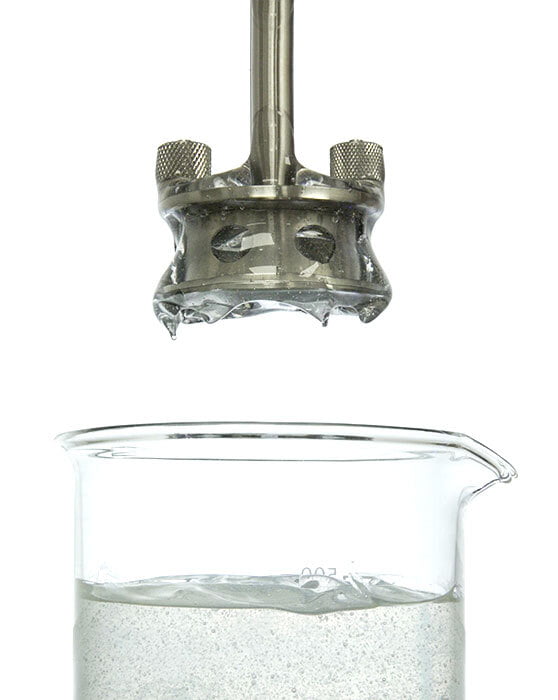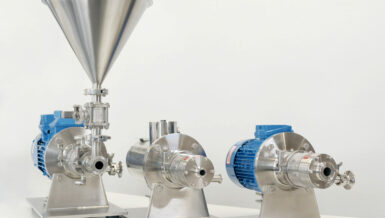In this video, Tumi Siwoku, Principal Chemist at Beauty Science Labs, shares her experience in the cosmetics industry and walks Silverson’s James Cardus through the step-by-step process of creating a clear, viscous, aeration-free gel. She explains how pH-sensitive polymers like acrylates copolymer respond to sodium hydroxide and how proper mixing technique makes all the difference.
The resulting product is a cold-processed gel base. These neutral gels are widely used across the cosmetics and personal care sector, serving as the foundation for gel moisturisers, styling products, topical treatments, and various skincare formulations, and can be easily customised with active ingredients, fragrances, or colourants.
Another essential factor in the formulation of a clear gel is keeping aeration to a minimum. This is particularly important with gels and other viscous products because entrapped air can’t easily rise to the surface. Aeration can also affect the viscosity of the gel and causes issues with filling lines.
With a conventional stirrer or agitator, vigorous in tank movement is required to complete some mixing tasks, and this can lead to aeration. A Silverson mixer minimises and in many cases eliminates aeration because the circulatory pattern of mixing is all below the surface. Although not discussed in the Cold Processing video, Silverson offer production scale models for cosmetic applications such as the creation of gels and other viscous products. In terms of minimising aeration, even better results can be obtained by mixing in line rather than with an in tank device.
Silverson In-Line mixers offer aeration-free operation. The return pipe from the In-Line Mixer is situated in the tank below the liquid surface, so it’s a closed system and aeration is completely eliminated.
In the Hot Process video, Tumi explains the concept of a Hot Process Emulsion and how the Silverson laboratory homogeniser enables the formation of high-quality creams and lotions. She also explains the different phases, the ingredients in each phase and the importance of mixing each of the phases at the correct temperature. Viewers are able to see how the Silverson Laboratory mixer is able to maintain uniform mixing throughout, delivering a consistent, stable emulsion.
As mentioned, Silverson Laboratory mixers are used for a variety of mixing processes from simple liquid/liquid blending, forming emulsions and reducing particle size to more complex mixing applications. They are ideal for all routine laboratory work, research and development, QA analysis and small scale production.
The ‘standard’ L5M-A model is the latest development in high shear laboratory mixing. The advantage of a Silverson over simple agitators and stirrers stems from the specially designed rotor/stator workhead; the high speed rotation of the rotor blades draws materials into the workhead where they are intensively mixed, before being projected back into the body of the mix at high velocity. With this method, ingredients are fully incorporated and any agglomerates are eliminated.
With its integral tachometer, ammeter and programmable timer, the L5M-A laboratory homogeniser offers a level of instrumentation invaluable in applications where process validation and repeatability are required. The L5M-A can also be supplied with a temperature probe which can be invaluable in this application, as seen in the Hot Process video.
As Tumi explains, temperature plays a critical role, not only in combining the oil and water phases, but also in determining when to add temperature-sensitive components. Ingredients such as fragrances, colorants, preservative systems, and extracts must be incorporated below a specific threshold to maintain their efficacy and stability.
The key to combining the oil and water phases successfully and obtaining a stable emulsion, is to use mixing equipment that can reduce the phases to the finest possible droplet size. The more shear energy introduced into the mix, the smaller the suspended droplets will become.
The high shear rotor/stator design of the Silverson mixer is ideally suited to this application and can easily achieve emulsions with a droplet size of 2 to 5 microns. In certain formulations, even finer emulsions down to 0.5 microns can be obtained.
As well as the L5M-A Laboratory mixer, Silverson also offers a wide range of in-tank and In-Line mixers suitable for emulsion preparation across various applications.
To find out more, visit the Silverson website.











